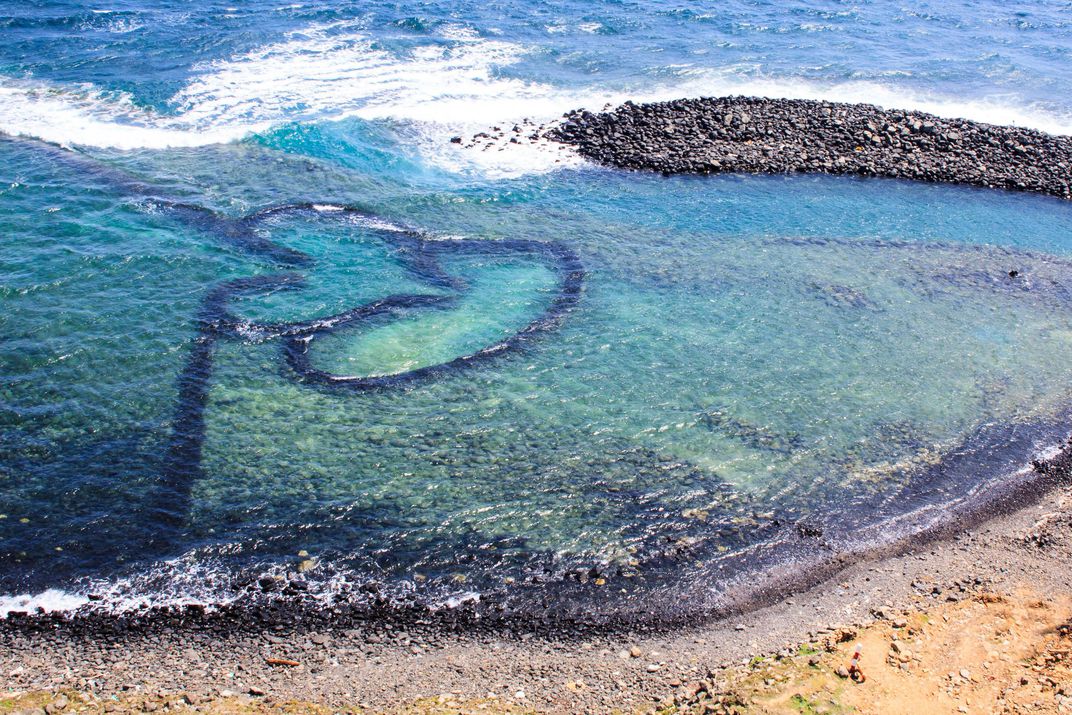Flying above the straits of Taiwan, you may see something strange: a massive set of curved lines running along the shore forming two hearts nestled together. And you’ll notice others as well—570 of these constructions dot the coast in the Penghu area. Though reminiscent of artistic earthworks, these stunning structures are actually ancient tidal fish traps, used for centuries in Taiwan to feed the local community. The most famous of these traps, the Twin-Heart Weir, has become one of the most photographed destinations in Taiwan, particular for couples, and though originally built as a anchovy killing field, has become a symbol of love. Other unique shapes include one that looks like a giant heart-shaped pendant on a necklace, and another structure that looks like two outstretched legs. Penghu’s collection of intact tidal traps is the largest anywhere in the world.
Back in the late 1600s and early 1700s, fishing in Taiwan was a major enterprise. Fisherman were known to catch silver-stripe round herring, Indian anchovy, greater amberjack and more, in hauls that could reach up to 1,300 pounds. They weren’t pulling in these massive catches with a rod or a net, though—they were were capturing them in these elaborate stone weirs. The biggest ones, stretching nearly two miles long and about 900 feet wide, took decades to complete.
The walls of the weirs were built such that the sea level at high tide would surpass the walls of the weir, a spokesperson at Taiwan’s Fisheries Agency explained. Fish would swim into an opening at one end, then when the tide went out, the fish would become trapped within the walls, which would then be higher than the ebbing sea level. Once the tide receded, local fisherman would walk the stone walls of the weir and catch fish with nets, spears, baskets, and other means.
Constructing the weirs was often a family project or one for the whole village, with one person in charge of the project who would select co-builders and delegate tasks. The group would observe tides over time and decide where to build the weir based on water flow and currents. Then, everyone would work together, stacking rocks to stop water from encroaching on the build site, lugging basalt to the spot to construct the main shape of the weir, and filling in holes with coral and limestone.
Many of the weirs incorporated curves, taking advantage of a known tendency for fish to turn around when they hit a curved surface. The fish will keep turning, continually hitting curves in the weir, and ultimately get stuck. For many centuries, stone weirs were considered an ideal method for catching fish, not only because of the sheer volume that would come in with the tide, but also because they created diverse tidal pools. The weir enclosures would foster an abundance of oyster, shrimp, crab and anemones. Although stone weirs were not unique to Taiwan—in fact, they popped up throughout the world, though primarily concentrated around Pacific island locations—Penghu has the densest existing collection.
Use of the weirs gradually began to decline near the end of the 1950s with the introduction of motorized fishing boats and enhanced fishery technology, plus a decreasing supply of fish, but their remains still dot the coastlines of Taiwan today.
“At present, [the only] counties or cities in Taiwan that still preserve the stone fish weirs are Penghu County, Taoyuan City and Miaoli County,” the Fisheries spokesperson said. “The stone fish weirs are most concentrated in Penghu County for the demonstration and promotion of its local fisheries culture.” At one point, weirs existed all over Taiwan’s coast, but many were destroyed by nature or fell into disrepair. In Penghu, the community maintains an effort to keep them in good shape as a tribute to its cultural practices and heritage. In fact, Penghu continues to hold fishing demonstrations with these ancient engineering marvels today in a festival called the Penghu Stone Weir Festival. The biggest cluster of the weirs is around Jibei and Qimei Islands in Penghu, where 88 can be found close together. Some can only be visited by boat, as many are on island coasts.

